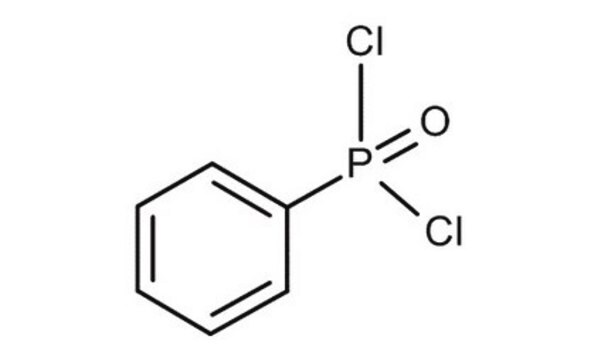Products may be shipped at a different temperature than the recommended long-term storage temperature. If the product quality is sensitive to short-term exposure to conditions other than the recommended long-term storage, it will be shipped on wet or dry-ice. If the product quality is NOT affected by short-term exposure to conditions other than the recommended long-term storage, it will be shipped at ambient temperature. As shipping routes are configured for minimum transit times, shipping at ambient temperature helps control shipping costs for our customers. For more information, please refer to the Storage and Transport Conditions document: https://www.sigmaaldrich.com/deepweb/assets/sigmaaldrich/marketing/global/documents/316/622/storage-transport-conditions-mk.pdf
389560
Phenylphosphonic dichloride
technical grade, 90%
Sinónimos:
Benzenephosphonic dichloride, Benzenephosphonyl chloride, Phenyldichlorophosphine oxide, Phenylphosphonyl dichloride, Phenylphosphoryl dichloride, P,P-Dichlorophenylphosphine oxide
Seleccione un Tamaño
Seleccione un Tamaño
About This Item
Productos recomendados
grado
technical grade
Ensayo
90%
Formulario
liquid
idoneidad de la reacción
reaction type: Buchwald-Hartwig Cross Coupling Reaction
reaction type: Heck Reaction
reaction type: Hiyama Coupling
reaction type: Negishi Coupling
reaction type: Sonogashira Coupling
reaction type: Stille Coupling
reaction type: Suzuki-Miyaura Coupling
reagent type: ligand
índice de refracción
n20/D 1.559 (lit.)
bp
258 °C (lit.)
mp
3 °C (lit.)
densidad
1.375 g/mL at 25 °C (lit.)
cadena SMILES
ClP(Cl)(=O)c1ccccc1
InChI
1S/C6H5Cl2OP/c7-10(8,9)6-4-2-1-3-5-6/h1-5H
Clave InChI
IBDMRHDXAQZJAP-UHFFFAOYSA-N
¿Está buscando productos similares? Visita Guía de comparación de productos
Aplicación
It can be used:
- In the synthesis of PBPP (3,9-diphenyl-3,9-dioxa-2,4,8,10-tetraoxa-3,9-diphosphaspiro-5,5-undecane), another organo-phosphorus flame retardant.[2]
- As a reactant in the synthesis of perfluoroalkyl(phenyl)phosphinic acids from perfluoroalkyl Grignard reagents.[3]
- As a starting material for the synthesis of benzoxazine monomer containing phenylphosphine oxide which can be polymerized via ring-opening polymerization.[4]
- As a chlorinating agent for the conversion of thienopyrimidinedione into 4,6-dichlorothienopyrimidine.[5]
Palabra de señalización
Danger
Frases de peligro
Consejos de prudencia
Clasificaciones de peligro
Acute Tox. 4 Oral - Eye Dam. 1 - Skin Corr. 1B - STOT SE 3
Órganos de actuación
Respiratory system
Riesgos supl.
Código de clase de almacenamiento
8A - Combustible corrosive hazardous materials
Clase de riesgo para el agua (WGK)
WGK 3
Punto de inflamabilidad (°F)
399.2 °F
Punto de inflamabilidad (°C)
204 °C
Equipo de protección personal
Faceshields, Gloves, Goggles, type ABEK (EN14387) respirator filter
Elija entre una de las versiones más recientes:
¿Ya tiene este producto?
Encuentre la documentación para los productos que ha comprado recientemente en la Biblioteca de documentos.
Los clientes también vieron
-
How is shipping temperature determined? And how is it related to the product storage temperature?
1 answer-
Helpful?
-
-
How can I determine the shelf life / expiration / retest date of this product?
1 answer-
If this product has an expiration or retest date, it will be shown on the Certificate of Analysis (COA, CofA). If there is no retest or expiration date listed on the product's COA, we do not have suitable stability data to determine a shelf life. For these products, the only date on the COA will be the release date; a retest, expiration, or use-by-date will not be displayed.
For all products, we recommend handling per defined conditions as printed in our product literature and website product descriptions. We recommend that products should be routinely inspected by customers to ensure they perform as expected.
For products without retest or expiration dates, our standard warranty of 1 year from the date of shipment is applicable.
For more information, please refer to the Product Dating Information document: https://www.sigmaaldrich.com/deepweb/assets/sigmaaldrich/marketing/global/documents/449/386/product-dating-information-mk.pdfHelpful?
-
Active Filters
Nuestro equipo de científicos tiene experiencia en todas las áreas de investigación: Ciencias de la vida, Ciencia de los materiales, Síntesis química, Cromatografía, Analítica y muchas otras.
Póngase en contacto con el Servicio técnico













